Edgardo Carmona Collection
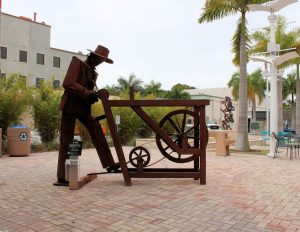 Included in the City of Fort Myers public art collection are 23 Cor-Ten sculptures created by Columbian artist Edgardo Carmona. They include (in alphabetical order):
Included in the City of Fort Myers public art collection are 23 Cor-Ten sculptures created by Columbian artist Edgardo Carmona. They include (in alphabetical order):
1. Al Filo (The Knife Sharpener): In today’s disposable market, where restaurants and homeowners simply throw out dull cutlery, knife sharpeners have become a dying breed. Through this piece, 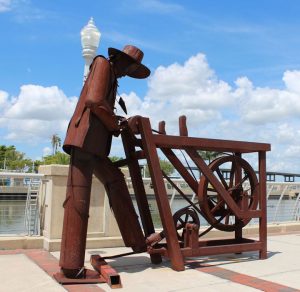 Carmona brings to life the forgotten the memory of the old knife sharpener, whose motorized stone wheel emitted a deep growl and glittering sparks that once seared themselves into the mind of the children of Cartagena and fabric of the community’s spirit. [Outside of Fort Myers, one would have to travel to Frosolone, Italy to find a life-size statue of a knife maker/sharpener. The town of about 3,300 is known historically for its knife craftsmanship and, in addition to the statue, has a museum dedicated to knives and scissor-making and hosts an annual “forging
Carmona brings to life the forgotten the memory of the old knife sharpener, whose motorized stone wheel emitted a deep growl and glittering sparks that once seared themselves into the mind of the children of Cartagena and fabric of the community’s spirit. [Outside of Fort Myers, one would have to travel to Frosolone, Italy to find a life-size statue of a knife maker/sharpener. The town of about 3,300 is known historically for its knife craftsmanship and, in addition to the statue, has a museum dedicated to knives and scissor-making and hosts an annual “forging 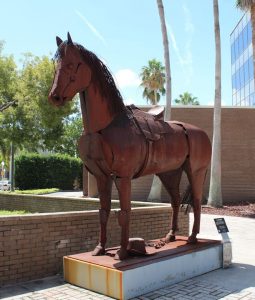 festival” that draws thousands.]
festival” that draws thousands.]
2. Al Galope (The Horse): This piece portrays both intensity and restriction, beauty and simplicity. Although standing still, the horse is both awake and eager to gallop.
3. Anquila (Eel): In this sculpture, Carmona captures the subtlety of the eel’s movement. More than simply sculpting a sea creature that spends its life in the waters of rivers and oceans, the artist focuses on bringing to life the subtle movements that seem to flow in the air.
4. Apareo: 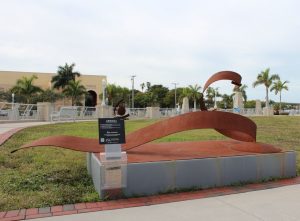 Resembling a symphony, this piece recreates the movement, intimacy and silent music that exists between two organisms during the act of mating.
Resembling a symphony, this piece recreates the movement, intimacy and silent music that exists between two organisms during the act of mating.
5. Cadencia (Bongo Drummer): An old African myth postulates that the drum can wake up and play itself independent of its player. The drums integrate themselves to the body and hands of the artist, 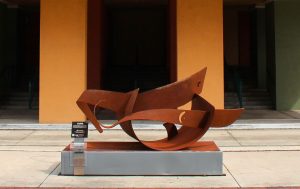 as if they were one. This harmonic sculpture creates one single integrated rhythm.
as if they were one. This harmonic sculpture creates one single integrated rhythm.
6. Caracol (Snail’s Shell): With minimalist intensity and limited lines and shapes, in this piece Carmona captures the mysterious beauty and spiral body that sleeps below the snail’s hard shell.
7 Deshove (Fertilization): In this artwork, the artist employs just 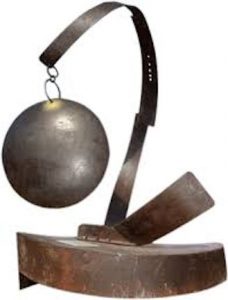 a few elements to recreate the moment of fertilization. The release of the fish eggs is defined in this sculpture as a large circle; the process of fertilization in the form of curves.
a few elements to recreate the moment of fertilization. The release of the fish eggs is defined in this sculpture as a large circle; the process of fertilization in the form of curves.
8. Don Quijote: In this piece, the sculptor recreates the famous character Don Quixote from the classic Spanish novel The Ingenious Gentleman Dox Quixote de La Mancha by Miguel de Cervantes Saavedra. Anxious to begin his battle, the expression of hope and illusion is clearly depicted on the adventurous character’s face. This sculpture is also a tribute to the character Don Quixote Incarnates – the utopian spirit of following one’s own dreams.
9. Duo Sinfonico (Man Playing Flute)
10. Ena En La Plaza (Ribbon Routine): This sculpture creates two integrated movements – the body of the 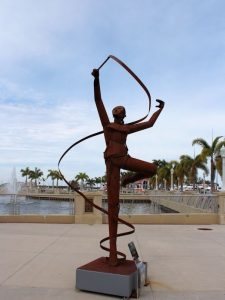 rhythmic gymnast playing with a ribbon and the spirals that spread in the wind as she engages in a dance that defines gravity. This interplay underscores balance, movement, internal and external strength which combine to find and express a sublime, poignant moment in time. [Rhythmic gymnastics has been an Olympic sport since 1984. Compulsory elements include flicks, circles, snakes, spirals and throws. Routines require a high degree of coordination to form the spirals and circles. Judges look for large, smooth, flowing movements and penalize any knots which may accidentally form in the ribbon during the routine.]
rhythmic gymnast playing with a ribbon and the spirals that spread in the wind as she engages in a dance that defines gravity. This interplay underscores balance, movement, internal and external strength which combine to find and express a sublime, poignant moment in time. [Rhythmic gymnastics has been an Olympic sport since 1984. Compulsory elements include flicks, circles, snakes, spirals and throws. Routines require a high degree of coordination to form the spirals and circles. Judges look for large, smooth, flowing movements and penalize any knots which may accidentally form in the ribbon during the routine.]
11. Faena En La Plaza (Unicycle Juggler): In this piece, Carmona depicts a 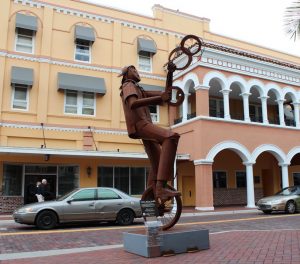 juggler sitting atop his unicycle with his rings ready for action while the wind tests his balance. [Cartagena is known universally for its numerous plazas, and Plaza de la Trinidad in the grungy Gethsemane district treats tourists from all over the world to lovely little restaurants and bars and all manner of enthusiastic street performers, from hip-hop dancers to jugglers and acrobats who jump and spin to the sound of breaking, locking and popping. But it was actually a Scottish performer who went by
juggler sitting atop his unicycle with his rings ready for action while the wind tests his balance. [Cartagena is known universally for its numerous plazas, and Plaza de la Trinidad in the grungy Gethsemane district treats tourists from all over the world to lovely little restaurants and bars and all manner of enthusiastic street performers, from hip-hop dancers to jugglers and acrobats who jump and spin to the sound of breaking, locking and popping. But it was actually a Scottish performer who went by 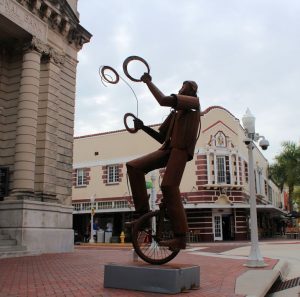 the stage name of Boy Foy who pioneered the art of unicycle juggling in the mid-1930s. In addition to quarter-inch-thick wood rings, Foy’s act consisted of 3 and 4 club routines, 3 top hats, ball-and-mouth stick work, and several combination tricks. At the peak of his 50-year career, he also performed a cups-and saucers routine.]
the stage name of Boy Foy who pioneered the art of unicycle juggling in the mid-1930s. In addition to quarter-inch-thick wood rings, Foy’s act consisted of 3 and 4 club routines, 3 top hats, ball-and-mouth stick work, and several combination tricks. At the peak of his 50-year career, he also performed a cups-and saucers routine.]
12. Juego De Ajedrez (The Chess Players): In this piece, Carmona portrays the containment of the opponents as they sit face to face across a chess board. 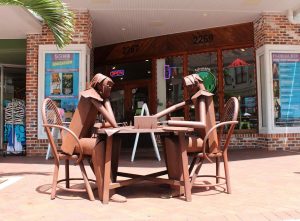 Each move could lead to victory or failure. The expressions on the players’ faces and gestures they make with their hands are the result of thorough observation. The artist sketched out several versions of this sculpture, testing his knowledge of the game and the implications of the moves and scenarios of the players’ expressions. “Chess and dominos are not the same,” Carmona has pointed out.
Each move could lead to victory or failure. The expressions on the players’ faces and gestures they make with their hands are the result of thorough observation. The artist sketched out several versions of this sculpture, testing his knowledge of the game and the implications of the moves and scenarios of the players’ expressions. “Chess and dominos are not the same,” Carmona has pointed out. 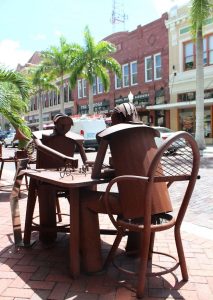 “There is a specific spirit to each game.” [This particular sculpture depicts two chess players in a square outside Iglesia de San Pedro Claver in Cartagena. Chess is a favorite pastime in Cartagena, with many locals flocking to the Liga de Ajedres or Chess League on the corner of Plaza Bolivar for a game on tables set up beneath a painting of a wizard-type character gazing over a chess set.]
“There is a specific spirit to each game.” [This particular sculpture depicts two chess players in a square outside Iglesia de San Pedro Claver in Cartagena. Chess is a favorite pastime in Cartagena, with many locals flocking to the Liga de Ajedres or Chess League on the corner of Plaza Bolivar for a game on tables set up beneath a painting of a wizard-type character gazing over a chess set.]
13. Juego de Domino (Domino Players): Domino players are an emblematic part of tradition and life in the Caribbean and Antilles. This piece depicts the simplicity and ease of outdoor Caribbean living. The players sit around a domino game and strategize each move based on their 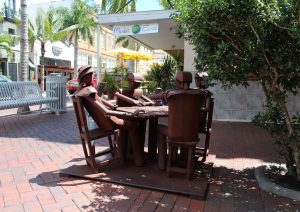 decoding of missing pieces to complete the game.
decoding of missing pieces to complete the game.
14. Mambeo: This sculpture pays homage to the indigenous Kogui community in Santa Marta’s Sierra Nevada. The tribe’s leader, “El Mamo, is brought to life in this sculpture, which depicts a common practice of chewing on coca leaves. [The centuries-old tradition of chewing coca leaves is especially popular 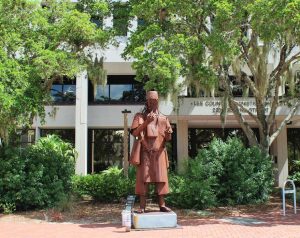 among working class Columbians, particularly those engaged in physically-demanding labor. Chewing coca leaves acts as an appetite suppressant, helps with altitude sickness, provides energy and improves digestion. Contrary to popular belief, the leaves do not release cocaine, provide no high when chewed and are not addictive.]
among working class Columbians, particularly those engaged in physically-demanding labor. Chewing coca leaves acts as an appetite suppressant, helps with altitude sickness, provides energy and improves digestion. Contrary to popular belief, the leaves do not release cocaine, provide no high when chewed and are not addictive.]
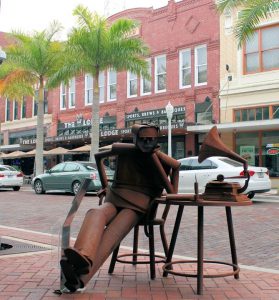 15. Melomano (Music Lover): This sculpture captures three elements: setting, position and mystery. It transports viewers to a scene where a music lover sits in his rocking chair listening to music. He sits in a position of excitement and curiosity, bringing his ear close to the speaker to ensure he is able to capture every note. It creates a sense of mystery and allure as to what could be so magical in this song.
15. Melomano (Music Lover): This sculpture captures three elements: setting, position and mystery. It transports viewers to a scene where a music lover sits in his rocking chair listening to music. He sits in a position of excitement and curiosity, bringing his ear close to the speaker to ensure he is able to capture every note. It creates a sense of mystery and allure as to what could be so magical in this song.
16. Negacion A Baco (Two Drunks on a Park Bench): This piece takes place in the late evening hours, narrating the story of what takes place after the work day is over 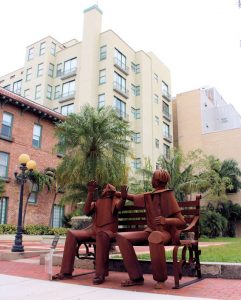 and recreates the conflicts of those that have had too much to drink. As they sit on a park bench, one man refuses to take another drink. The gestures of the characters and the movement of their hands in the air tell a story, incorporating irony, humor and studied emotions.
and recreates the conflicts of those that have had too much to drink. As they sit on a park bench, one man refuses to take another drink. The gestures of the characters and the movement of their hands in the air tell a story, incorporating irony, humor and studied emotions.
17. Nostalgia De Cuerdas: The suggestion completes the hand of the one who plays the strings in this sculpture. The artist discovers that the figurative can be reinvented with silence and space.
18. Sintonia (Nostalgic Tune on the Radio): In this sculpture, Carmona 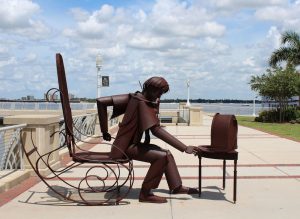 captures a moment where time sits still and nothing else matters as the subject, sitting in his rocking chair, listens to the news on the radio while reading a favorite book. This work of art depicts the nostalgia of passing time. The scene stays embedded in our memories forever. [This work was inspired by Carmona’s father, a college math professor who spent a lot of time listening to the news on his radio.
captures a moment where time sits still and nothing else matters as the subject, sitting in his rocking chair, listens to the news on the radio while reading a favorite book. This work of art depicts the nostalgia of passing time. The scene stays embedded in our memories forever. [This work was inspired by Carmona’s father, a college math professor who spent a lot of time listening to the news on his radio. 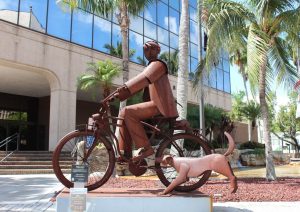 “He was very attuned to what was happening in the entire city,” Carmona said about his father. “He lived with his own frequency in his own world.”]
“He was very attuned to what was happening in the entire city,” Carmona said about his father. “He lived with his own frequency in his own world.”]
19. Trialogo (Cyclist and Dog): In this piece, Carmona outlines extremes, depicting limits but also infinites, showing the tangible as well as the intangible. Object, subject, animal, gestures and movement create 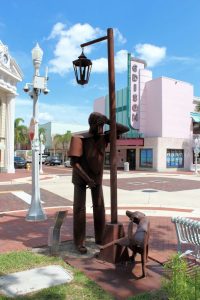 one single moment in this sculptural display, which features accuracy in line, volume and shape. The dog runs towards the pedaling cyclist attempting to bite at his heel, while at the same time challenging the bicycle itself. This sculpture depicts gestures while creating a scene with movement.
one single moment in this sculptural display, which features accuracy in line, volume and shape. The dog runs towards the pedaling cyclist attempting to bite at his heel, while at the same time challenging the bicycle itself. This sculpture depicts gestures while creating a scene with movement.
20. Territorios: This sculpture presents the irony encapsulated by a dog “marking his territory” in the same way as the man who’s leaning against the light pole. When originally unveiled, Territorias stirred a bit of controversy. Although the Public Art Committee hadn’t noticed this detail when they originally reviewed images of the sculptures, the Committee refused to give in to demands for the artwork’s removal and today it is one of the 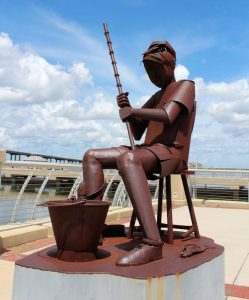 collection’s most popular pieces. Some people think it’s humorous; others simply concede it as a fact of life. A watercolor artist painted an image of the work and printed it on t-shirts, which quickly sold out.
collection’s most popular pieces. Some people think it’s humorous; others simply concede it as a fact of life. A watercolor artist painted an image of the work and printed it on t-shirts, which quickly sold out.
21. Utopia (Boy Fishing from a Bucket): This sculpture depicts a boy fishing from a bucket. Because of its message and meaning, it is Carmona’s most tender piece. It brings to life Rafael Pombo’s Simon El Bobito, a local children’s story about a boy who fishes from a bucket, Carmona gives this common story a new and happy ending, bringing triumph and happiness to Simon by giving him a fish to capture from his bucket. 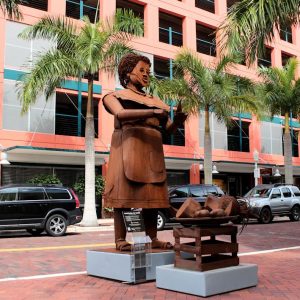 This piece creates a message around the Pygmalion effect and the theory of self-realization.
This piece creates a message around the Pygmalion effect and the theory of self-realization.
22. Vendedora De Frutas (Female Fruit Seller): One of the most emblematic characters of Cartegena de Indias is the palenquera, a female fruit seller of San Basilio de Palenque. This piece depicts the majestic figure of the palenquera, with her grand fruit basket sitting above her head, as if she carried with her the weight of the world.
23. Vendedor De Raspaos 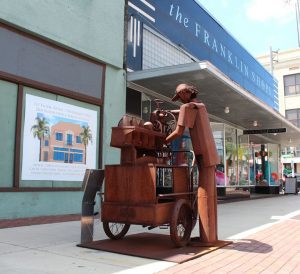 (Snow Cone Vendor): The snow cone street vendor is an iconic character found in the landscape of Cartagena de Indias. The hands of the street vendor selling “raspaos” (snow cones) transform giant blocks of ice into miniscule pieces of shaved ice. The condensed milk drips perfectly atop the sweet flavors of lime, tamarind and Kola.
(Snow Cone Vendor): The snow cone street vendor is an iconic character found in the landscape of Cartagena de Indias. The hands of the street vendor selling “raspaos” (snow cones) transform giant blocks of ice into miniscule pieces of shaved ice. The condensed milk drips perfectly atop the sweet flavors of lime, tamarind and Kola.
These descriptions notwithstanding, Carmona hopes that viewers will formulate their own opinion of the meaning for 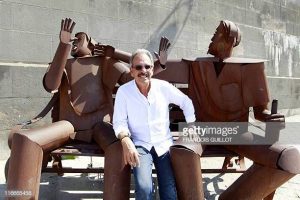 each piece. “Once you see it, you have the ability to create your own story, in your own imagination,” Carmona says. That being the case, Carmona’s inspiration for each piece shouldn’t matter to the viewer. Everyone will see something different and experience the sculptures from their own viewpoint.
each piece. “Once you see it, you have the ability to create your own story, in your own imagination,” Carmona says. That being the case, Carmona’s inspiration for each piece shouldn’t matter to the viewer. Everyone will see something different and experience the sculptures from their own viewpoint.
About Edgardo Carmona
 Edgardo Carmona was born in Cartagena, Columbia to a mathematician father who encouraged his son to study Mechanical Engineering and Business Administration. Although he also studied painting and sculpture, Carmona embarked upon a career in constructing steel buildings and designing machines. This formed the basis for working of metals, which is his medium of
Edgardo Carmona was born in Cartagena, Columbia to a mathematician father who encouraged his son to study Mechanical Engineering and Business Administration. Although he also studied painting and sculpture, Carmona embarked upon a career in constructing steel buildings and designing machines. This formed the basis for working of metals, which is his medium of 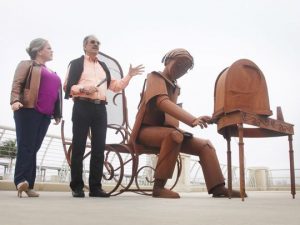 choice in many of his sculptures, including his designs in downtown Fort Myers.
choice in many of his sculptures, including his designs in downtown Fort Myers.
Carmona has displayed his art throughout Europe and parts of South America including the cities of Munich, Paris, Panama City, and Bogota. The installation that Fort Myers ultimately purchased toured Europe, making stops in 18 cities in Germany, Italy and France. Many of his works are on permanent display around the world.
His Process
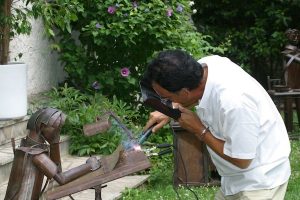 Carmona uses hydraulic machines, sandblasting and a special method to remove the calamine from the rust and stop the oxidation process. By design, the rust gives each piece a pleasing, colorful patina.
Carmona uses hydraulic machines, sandblasting and a special method to remove the calamine from the rust and stop the oxidation process. By design, the rust gives each piece a pleasing, colorful patina.
Provenance
Condominium developer Eduardo Caballaro invited Edgardo Carmona to bring his installation to Fort Myers for its North American debut in order to promote a two-tower 292-room condominium project his company, JAXI Builders, is building on on Fort Myers’ waterfront. Caballaro and Carmona were childhood friends in Cartagena, Colombia. When Caballaro shared Fort Myers’ history (particularly the role of the Calusa Indians), the artist felt his exhibit–with its focus on people who might otherwise go unnoticed–would fit right in. The fact that he could help his friend promote his new condo development didn’t hurt either.
The exhibition was originally scheduled to be transported to Spain when the show ended in March of 2016. After several extensions, the City entered into negotiations with Carmona for purchase of the entire exhibition. The purchase was consummated on August 6, 2018 with approval of the contract for sale and purchase by Fort Myers City Council.
_______________________________________________________________
RELATED ARTICLES AND LINKS.
Fort Myers consummates acquisition of Edgard Carmona sculptures (08-12-18)
 Following months of negotiations with Columbian sculptor Edgardo Carmona, the City of Fort Myers has acquired the 23-piece installation of “likable characters” from Cartagena that were first unveiled in the downtown Fort Myers River District in January of 2016 by JAXI Builders to promote its two-tower Allure luxury condominium project. City Council approved the purchase at its August 6 meeting.
Following months of negotiations with Columbian sculptor Edgardo Carmona, the City of Fort Myers has acquired the 23-piece installation of “likable characters” from Cartagena that were first unveiled in the downtown Fort Myers River District in January of 2016 by JAXI Builders to promote its two-tower Allure luxury condominium project. City Council approved the purchase at its August 6 meeting.
While some of the sculptures have stirred their fair share of controversy, most residents, worker and visitors express fondness for the figures, which represent ordinary people not typically featured in modern-day representational sculptures: a simple-minded fisherman, a woman  caught in a rainstorm, two drunks on a park bench, men playing chess, a fruit seller, a knife sharpener and more. They represent “the commonality of real people,” said Carmona of his subjects.
caught in a rainstorm, two drunks on a park bench, men playing chess, a fruit seller, a knife sharpener and more. They represent “the commonality of real people,” said Carmona of his subjects.
The sculptures are now subject to the purview of the City’s Public Art Committee, whose first order of business will be to decide whether all 23 pieces should remain where they are or several should be relocated to sites within Fort Myers’ other five wards.
The City’s  public art collection dates back to August 17, 1913 when the City accepted Dr. Marshall O.Terry’s donation of a fountain and horse trough honoring his late wife, Tootie McGregor Terry. The City received its second public artwork in 1926 with James D. Newton’s gift of The Spirit of Fort Myers, the Grecian maiden popularly known as Rachel at the Well who has now graced the entrance to Edison Park for more than 92 years.
public art collection dates back to August 17, 1913 when the City accepted Dr. Marshall O.Terry’s donation of a fountain and horse trough honoring his late wife, Tootie McGregor Terry. The City received its second public artwork in 1926 with James D. Newton’s gift of The Spirit of Fort Myers, the Grecian maiden popularly known as Rachel at the Well who has now graced the entrance to Edison Park for more than 92 years.
The City’s collection remained largely static for the next half century, but it experienced a 20-year growth spurt beginning in 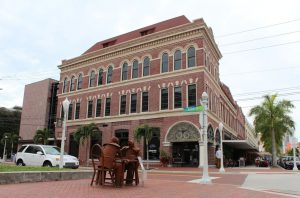 1982 when the Beautification Advisory Board commissioned North Fort Myers sculptor Don J. Wilkins to create a series of new fountains (such as Uncommon Friends and The Florida Panthers), outdoor sculptures (including the USCT 2d Regiment Memorial in Centennial Park) and indoor busts (that include the Harborside Collection).
1982 when the Beautification Advisory Board commissioned North Fort Myers sculptor Don J. Wilkins to create a series of new fountains (such as Uncommon Friends and The Florida Panthers), outdoor sculptures (including the USCT 2d Regiment Memorial in Centennial Park) and indoor busts (that include the Harborside Collection).
 With the addition of the 23 Carmona sculptures, the City’s public art collection now exceeds 60 artworks. But only a sculpture known as What Dreams May Fly and How They Fly installed by the Public Art Committee in Clemente Park in 2015 is located outside of Ward 4. And that reality has prompted a number of City Council members to urge the Committee to locate newly-commissioned artworks in the City’s other five wards. It therefore came as no surprise when Ward 2 Councilman Johnny B. Streets, Jr. stated during discussion preceding approval of the Carmona purchase that he’d like to see some of the sculptures moved to sites within the City’s other wards.
With the addition of the 23 Carmona sculptures, the City’s public art collection now exceeds 60 artworks. But only a sculpture known as What Dreams May Fly and How They Fly installed by the Public Art Committee in Clemente Park in 2015 is located outside of Ward 4. And that reality has prompted a number of City Council members to urge the Committee to locate newly-commissioned artworks in the City’s other five wards. It therefore came as no surprise when Ward 2 Councilman Johnny B. Streets, Jr. stated during discussion preceding approval of the Carmona purchase that he’d like to see some of the sculptures moved to sites within the City’s other wards.
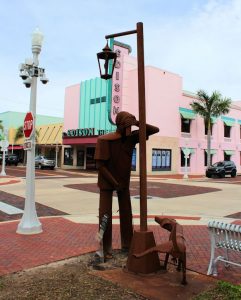 The sculptures are well-traveled. Before coming to Fort Myers, the installation completed an 18-city European tour with stops in Italy, Germany and France. One piece was even displayed in front of the Eiffel Tower. The Public Art Committee is expected to consider the possibility of breaking up the installation or rotating pieces among each of the City’s six wards once a year or more. Cost will be an important factor in the latter regard as each sculpture weighs between 200 and 1,000 pounds.
The sculptures are well-traveled. Before coming to Fort Myers, the installation completed an 18-city European tour with stops in Italy, Germany and France. One piece was even displayed in front of the Eiffel Tower. The Public Art Committee is expected to consider the possibility of breaking up the installation or rotating pieces among each of the City’s six wards once a year or more. Cost will be an important factor in the latter regard as each sculpture weighs between 200 and 1,000 pounds.
The Committee will also discuss whether to include some of all of the Carmona sculptures on Otocast, a free smartphone app that provides 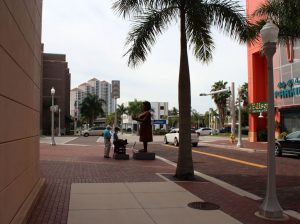 narrative and audio recordings explaining specific artworks to the people who visit, live and work in the River District. Most people who encounter Fort Myers’ outdoor artworks have no idea who made them or what they represent. The City’s Public Art Committee hopes to change that equation with the launch of its free Otocast phone app.
narrative and audio recordings explaining specific artworks to the people who visit, live and work in the River District. Most people who encounter Fort Myers’ outdoor artworks have no idea who made them or what they represent. The City’s Public Art Committee hopes to change that equation with the launch of its free Otocast phone app.
According to urban planners, 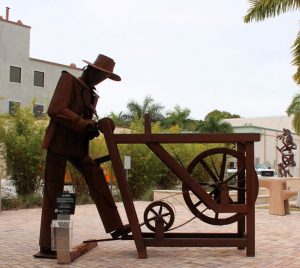 economists and public art professionals, people who live and work in communities with a vibrant public art program enjoy more than three dozen interrelated benefits from the art that surrounds them. But these salutatory effects are only fully realized to the extent people are able to interact with the artworks on a physical, intellectual and emotional level. Otocast facilitates a deeper connection with public art by letting viewers in on behind-the-scenes stories previously
economists and public art professionals, people who live and work in communities with a vibrant public art program enjoy more than three dozen interrelated benefits from the art that surrounds them. But these salutatory effects are only fully realized to the extent people are able to interact with the artworks on a physical, intellectual and emotional level. Otocast facilitates a deeper connection with public art by letting viewers in on behind-the-scenes stories previously 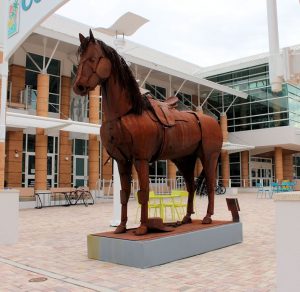 known only to the art insiders who commissioned, made and installed the sculptures, murals and other artworks that dot the urban landscape.
known only to the art insiders who commissioned, made and installed the sculptures, murals and other artworks that dot the urban landscape.
In this context, the Committee will now consider is whether interaction with the installation will be enhanced or undermined by relocating various pieces to the City’s other wards.
Meetings of the City of Fort Myers Public Art Committee are conducted in the sunshine and are open to the public. They are held on the third Tuesday of each month, and begin promptly at 4:00 p.m. Agendas are posted on the City’s website, which also contains videos of past meetings.
___________________________________________________________________
15 of City’s new Carmona sculptures to be moved to City’s other five wards (10-18-18)
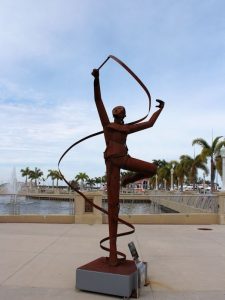 This past August, the City of Fort Myers purchased the 23 rust-colored sculptures that line the streets downtown and the east promenade that circles the City’s 1.8 acre river basin. But only seven of them will remain in River District locations. The City’s Public Art Committee resolved on Tuesday to move one of the pieces to the Edison & Ford Winter Estates and relocate 15 others to sites in the City’s other five wards.
This past August, the City of Fort Myers purchased the 23 rust-colored sculptures that line the streets downtown and the east promenade that circles the City’s 1.8 acre river basin. But only seven of them will remain in River District locations. The City’s Public Art Committee resolved on Tuesday to move one of the pieces to the Edison & Ford Winter Estates and relocate 15 others to sites in the City’s other five wards.
Over the past several years, City Council has regularly expressed the sentiment that public art should be interspersed throughout Fort Myers’ six wards so that all of its citizens can enjoy and be inspired by its public art collection. For a variety of reasons, the vast majority of the City’s 46 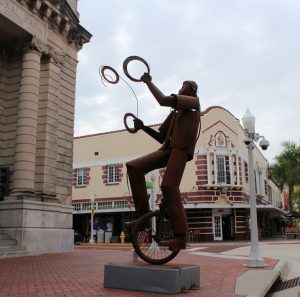 public artworks are located downtown. Many (such as Fire Dance, The Great Turtle Chase, Uncommon Friends, the USCT 2nd Regiment Monument and the Buckingham & Paige Army Air Field Memorial) reside in Centennial Park. Since relocating monumental sculptures and permanent installations is expensive and fraught with technological challenges, the idea was to site new commissions in Wards 1, 2, 3, 5 and 6.
public artworks are located downtown. Many (such as Fire Dance, The Great Turtle Chase, Uncommon Friends, the USCT 2nd Regiment Monument and the Buckingham & Paige Army Air Field Memorial) reside in Centennial Park. Since relocating monumental sculptures and permanent installations is expensive and fraught with technological challenges, the idea was to site new commissions in Wards 1, 2, 3, 5 and 6.
But then the Great 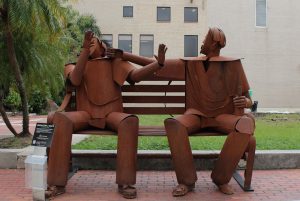 Recession struck and donations to the City’s public art fund dried up as building and development slowed and then stopped altogether. Thus, acquisition of the Allure/Carmona sculptures represents the first meaningful opportunity for the City’s Public Art Committee to place art on sites outside of Ward 4.
Recession struck and donations to the City’s public art fund dried up as building and development slowed and then stopped altogether. Thus, acquisition of the Allure/Carmona sculptures represents the first meaningful opportunity for the City’s Public Art Committee to place art on sites outside of Ward 4.
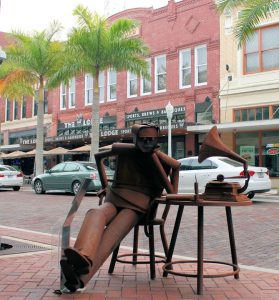 The seven sculptures that will remain downtown are:
The seven sculptures that will remain downtown are:
- Ena En La Plaza (Ribbon Routine)
- Faena En La Plaza (Unicycle Juggler)
- Negacion A Baco (Two Drunks on a Park Bench)
- Sintonia (Nostalgic Tune on the Radio)
- Territorias (Man and Dog Urinating on a Lamppost)
- Utopia (Boy Fishing from a Bucket)
- Vendedor De Raspaos (Snow Cone Vendor)
Ribbon Routine will be moved to the Collaboratory at 2301 Jackson Street (across from the bus terminal) that will celebrate its grand opening on Sunday. The exact location of the 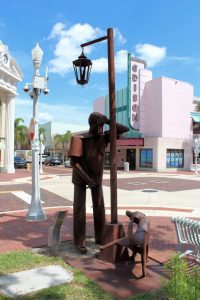 other six sculptures has yet to be determined and may change as work on the new Luminary Hotel and revamped convention center progresses.
other six sculptures has yet to be determined and may change as work on the new Luminary Hotel and revamped convention center progresses.
An eighth sculpture will be retained in Ward 4, although not downtown. Because it features a Victrola-style phonograph, Melomano (Music Lover) will be relocated to the Edison Ford Winter Estates in recognition of Thomas Edison’s special relationship to the phonograph. He invented the device, completing the first model on August 12, 1877, and he considered it his all-time favorite invention.
The Public Art Committee is working with each City Council member to identify sites within 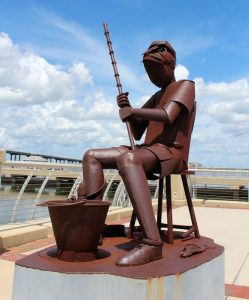 their wards for the other 15 Allure/Carmona sculptures. Once all the works have been moved to their new homes, the Public Art Committee expects to add text, photos and audio recordings to its free phone app known as Otocast so that residents, vacationers and cultural tourists can find, visit and learn about each of the 23 pieces, along with the City’s other 46 public artworks.
their wards for the other 15 Allure/Carmona sculptures. Once all the works have been moved to their new homes, the Public Art Committee expects to add text, photos and audio recordings to its free phone app known as Otocast so that residents, vacationers and cultural tourists can find, visit and learn about each of the 23 pieces, along with the City’s other 46 public artworks.
Naturally, Art Southwest Florida will report on future developments.














 Tom Hall is both an amateur artist and aspiring novelist who writes art quest thrillers. He is in the final stages of completing his debut novel titled "Art Detective," a story that fictionalizes the discovery of the fabled billion-dollar Impressionist collection of Parisian art dealer Josse Bernheim-Jeune, thought by many to have perished during World War II when the collection's hiding place, Castle de Rastignac in southern France, was destroyed by the Wehrmacht in reprisal for attacks made by members of the Resistance operating in the area. A former tax attorney, Tom holds a bachelor's degree as well as both a juris doctorate and masters of laws in taxation from the University of Florida. Tom lives in Estero, Florida with his fiancee, Connie, and their four cats.
Tom Hall is both an amateur artist and aspiring novelist who writes art quest thrillers. He is in the final stages of completing his debut novel titled "Art Detective," a story that fictionalizes the discovery of the fabled billion-dollar Impressionist collection of Parisian art dealer Josse Bernheim-Jeune, thought by many to have perished during World War II when the collection's hiding place, Castle de Rastignac in southern France, was destroyed by the Wehrmacht in reprisal for attacks made by members of the Resistance operating in the area. A former tax attorney, Tom holds a bachelor's degree as well as both a juris doctorate and masters of laws in taxation from the University of Florida. Tom lives in Estero, Florida with his fiancee, Connie, and their four cats.